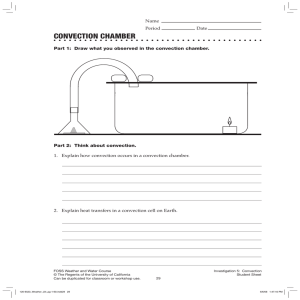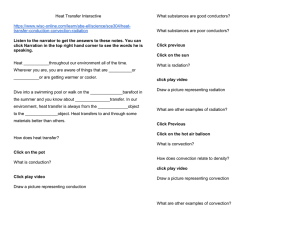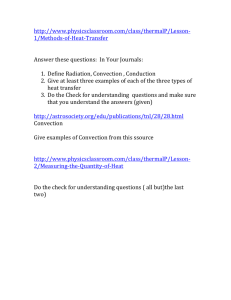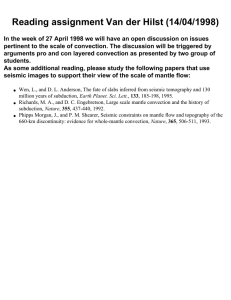Natural Convection
advertisement
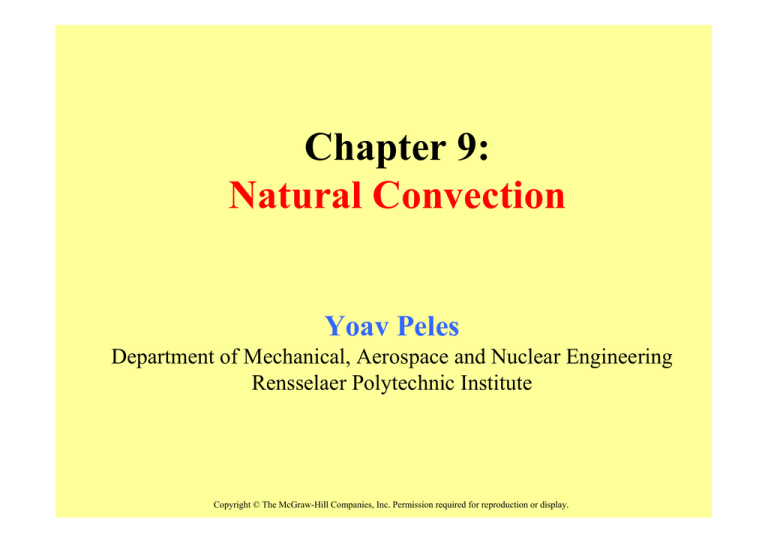
Chapter 9: Natural Convection Yoav Peles Department of Mechanical, Aerospace and Nuclear Engineering Rensselaer Polytechnic Institute Copyright © The McGraw-Hill Companies, Inc. Permission required for reproduction or display. Objectives When you finish studying this chapter, you should be able to: • Understand the physical mechanism of natural convection, • Derive the governing equations of natural convection, and obtain the dimensionless Grashof number by nondimensionalizing them, • Evaluate the Nusselt number for natural convection associated with vertical, horizontal, and inclined plates as well as cylinders and spheres, • Examine natural convection from finned surfaces, and determine the optimum fin spacing, • Analyze natural convection inside enclosures such as double-pane windows, and • Consider combined natural and forced convection, and assess the relative importance of each mode. • Buoyancy forces are responsible for the fluid motion in natural convection. • Viscous forces appose the fluid motion. • Buoyancy forces are expressed in terms of fluid temperature differences through the volume expansion coefficient 1 ⎛ ∂V ⎞ 1 ⎛ ∂ρ ⎞ β= ⎜ (1 K ) (9-3) ⎟ = ⎜ ⎟ V ⎝ ∂T ⎠ P ρ ⎝ ∂T ⎠ P Viscous Force Buoyancy Force volume expansion coefficient (β) • The volume expansion coefficient can be expressed approximately by replacing differential quantities by differences as 1 ∆ρ 1 ρ∞ − ρ β ≈− =− ( ) ρ ∆T ρ T∞ − T or ρ∞ − ρ = ρβ (T − T∞ ) ( at constant P ) ( at constant P ) (9-4) (9-5) • For ideal gas (Pv = RT) βideal gas 1 = T (1/K ) (9-6) Equation of Motion and the Grashof Number • Consider a vertical hot flat plate immersed in a quiescent fluid body. • Assumptions: – – – – – steady, laminar, two-dimensional, Newtonian fluid, and constant properties, except the density difference ρ -ρ∞ (Boussinesq approximation). g • Consider a differential volume element. • Newton’s second law of motion δ m ⋅ ax = Fx (9-7) g 其中 δ m = ρ ( dx ⋅ dy ⋅1) • The acceleration in the x-direction is obtained by taking the total differential of u(x, y) du ∂u dx ∂u dy ax = = + dt ∂x dt ∂y dt ∂u ∂u ax =u +v ∂x ∂y (9-8) in m Zoo P∞ • The net surface force acting in the x-direction Net pressure force Net viscous force Gravitational force ⎛ ∂τ ⎞ ⎛ ∂P ⎞ Fx = ⎜ dy ⎟ ( dx ⋅1) − ⎜ dx ⎟ ( dy ⋅1) − ρ g ( dx ⋅ dy ⋅1) ⎝ ∂x ⎠ ⎝ ∂y ⎠ ⎛ ∂ 2u ∂P ⎞ = ⎜µ 2 − − ρ g ⎟ ( dx ⋅ dy ⋅1) (9-9) ∂x ⎝ ∂y ⎠ • Substituting Eqs. 9–8 and 9–9 into Eq. 9–7 and dividing by ρ·dx·dy·1 gives the conservation of momentum in the x-direction ⎛ ∂u ∂u ⎞ ∂ 2u ∂P ρ ⎜u + v ⎟ = µ 2 − − ρg ∂y ⎠ ∂y ∂x ⎝ ∂x (9-10) • The x-momentum equation in the quiescent fluid outside the boundary layer (setting u = 0) ∂P∞ (9-11) = − ρ∞ g (靜力學) ∂x • Noting that – v<<u in the boundary layer and thus ∂v/ ∂x≈ ∂v/∂y ≈0, and – there are no body forces (including gravity) in the ydirection, the force balance in the y-direction is ∂P ∂P ∂P∞ =0 = = − ρ∞ g ∂y ∂x ∂x Substituting into Eq. 9–10 ⎛ ∂u ∂u ⎞ ∂ 2u ρ ⎜ u + v ⎟ = µ 2 + ( ρ∞ − ρ ) g ∂y ⎠ ∂y ⎝ ∂x (9-12) • Substituting Eq. 9-5 it into Eq. 9-12 and dividing both sides by ρ gives ∂u ∂u ∂ 2u u +v = ν 2 + g β (T − T∞ ) ∂x ∂y ∂y (9-13) • The momentum equation involves the temperature, and thus the momentum and energy equations must be solved simultaneously. • The set of three partial differential equations (the continuity, momentum, and the energy equations) that govern natural convection flow over vertical isothermal plates can be reduced to a set of two ordinary nonlinear differential equations by the introduction of a similarity variable. The Grashof Number • The governing equations of natural convection and the boundary conditions can be nondimensionalized T − T∞ x y u v * * * * ; y = ; u = ; v = ; T = x = Lc Lc V V Ts − T∞ * • Substituting into the momentum equation and simplifying give 3 * * * 2 * ⎡ ⎤ − g β T T L ( ) ∂ ∂ ∂ u u T u (9-14) 1 s ∞ c * * +v =⎢ u ⎥ 2 + * * 2 *2 ∂x ∂y ν Re L Re L ∂y ⎣ ⎦ GrL • The dimensionless parameter in the brackets represents the natural convection effects, and is called the Grashof number GrL GrL = GrL= g β (Ts − T∞ ) L3c ν 2 (9-15) Viscous force Buoyancy force Viscous force • The flow regime in natural convection is governed by the Grashof number GrL > 109 flow is turbulent Buoyancy force Natural Convection over Surfaces • Natural convection heat transfer on a surface depends on – – – – geometry, orientation, variation of temperature on the surface, and thermophysical properties of the fluid. • The simple empirical correlations for the average Nusselt number in natural convection are of the form hLc n (9-16) Nu ≡ = C ⋅ ( GrL ⋅ Pr ) = C ⋅ RaLn k • Where RaL is the Rayleigh number g β (Ts − T∞ ) L3c Pr RaL = GrL ⋅ Pr = 2 ν (9-17) • The values of the constants C and n depend on the geometry of the surface and the flow regime (which depend on the Rayleigh number). • All fluid properties are to be evaluated at the film temperature Tf = (Ts+T∞). • The Nusselt number relations for the constant surface temperature and constant surface heat flux cases are nearly identical. • The relations for uniform heat flux is valid when the plate midpoint temperature TL/2 is used for Ts in the evaluation of the film temperature. • Thus for uniform heat flux: qs L hL L qs Nu = = ( )= k k ∆T k TL 2 − T∞ ( ) (9-27) Empirical correlations for Nuavg 1010 例題 g Ts = 1000C, T∞ = 300C, g = 9.8 m/s2, Pr = 0.7 Lc = 0.3 m, ν = 1.93 x 10-5 m2/s β ≈ 1 / Tavg = 1 / [(373.15+303.15) / 2] = 0.00296 K-1, k = 0.026 W/m-K RaL = GrL ⋅ Pr = g β (Ts − T∞ ) L3c ν 2 Pr = 1.03 x 108 GrL = 1.47 x 108 (laminar flow) Nu = havgLc/k = 0.59 (RaL)1/4 Lc=0.3 m = 80.3 Hence, havg = 7 (W/m2-K) Q = havg A (Ts – T∞) = havg (Lc w) (Ts – T∞) 空氣 Q/w = 147 (Watts) Natural Convection from Finned Surfaces • Natural convection flow through a channel formed by two parallel plates is commonly encountered in practice. • Long Surface – fully developed channel flow. • Short surface or large spacing – natural convection from two independent plates in a quiescent medium. • The recommended relation for the average Nusselt number for vertical isothermal parallel plates is hS ⎡ 576 2.873 ⎤ Nu = =⎢ + ⎥ 2 0.5 k ⎢ ( Ras S L ) ( Ras S L ) ⎥ ⎣ ⎦ −0.5 (9-31) • Closely packed fins – greater surface area – smaller heat transfer coefficient. • Widely spaced fins – higher heat transfer coefficient – smaller surface area. Ras ≡ gβ (Ts − T∞ ) S 3 ν 2 Pr ; RaL ≡ gβ (Ts − T∞ ) L3 ν2 L3 Pr = Ra s 3 S 固定 WL,自然熱傳量最大時 (Ts =constant) , 可推導: ⎛S L⎞ = 2.714 ⎜ ⎟ Ra ⎝ s⎠ 3 Sopt S opt = 2.714[ S = S opt ; S4 0.25 S Ras ( ) L ] 0.25 = 2.714 L RaL0.25 (9-32) S = 2.714 S [ Ras ( )]0.25 L T∞ S Ra s ( ) = 54.255 L 代回 (9-31) Nu = h Sopt / k = 1.307 n =片數 (9-33) 熱傳模組之總散熱量 = Q = h (2nLH) (Ts –T∞) (9-34) Natural Convection Inside Enclosures • In a vertical enclosure, the fluid adjacent to the hotter surface rises and the fluid adjacent to the cooler one falls, setting off a rotationary motion within the enclosure that enhances heat transfer through the enclosure. • Heat transfer through a horizontal enclosure – hotter plate is at the top ─ no convection currents (Nu=1). – hotter plate is at the bottom • Ra<1708 no convection currents (Nu=1). • 3x105>Ra>1708 Bénard Cells. • Ra>3x105 turbulent flow. Nusselt Number Correlations for Enclosures • Simple power-law type relations in the form of Nu = C ⋅ Ra where C and n are constants, are sufficiently accurate, but they are usually applicable to a narrow range of Prandtl and Rayleigh numbers and aspect ratios. n L • Numerous correlations are widely available for – – – – – horizontal rectangular enclosures, inclined rectangular enclosures, vertical rectangular enclosures, concentric cylinders, concentric spheres. Combined Natural and Forced Convection • Heat transfer coefficients in forced convection are typically much higher than in natural convection. • The error involved in ignoring natural convection may be considerable at low velocities. • Nusselt Number: – Forced convection (flat plate, laminar flow): Nuforced convection ∝ Re1 2 – Natural convection (vertical plate, laminar flow): Nunatural convection ∝ Gr1 4 • Therefore, the parameter Gr/Re2 represents the importance of natural convection relative to forced convection. • Gr/Re2 < 0.1 : natural convection is negligible. • Gr/Re2 > 10 : forced convection is negligible. • 0.1 < Gr/Re2 <10 : forced and natural convection are not negligible. hot isothermal vertical plate • Natural convection may help or hurt forced convection heat transfer depending on the relative directions of buoyancy-induced and the forced convection motions. Nusselt Number for Combined Natural and Forced Convection (Mixed Convection) • A review of experimental data suggests a Nusselt number correlation of the form ( Nucombined = Nu n forced ± Nu n natural ) 1n (9-66) • Nuforced and Nunatural are determined from the correlations for pure forced and pure natural convection, respectively.

